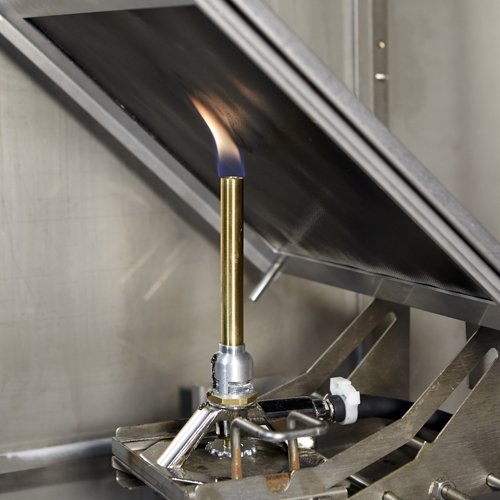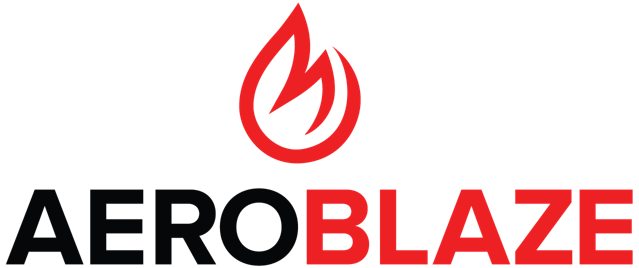45-degree Burn
45-Degree Bunsen Burner Test (for aviation)
The 45-Degree Bunsen Burner test is used by the aerospace/aviation industry to determine the resistance of materials to flame penetration with a flame applied for 30-seconds. It is most commonly used to show compliance with the cargo compartment requirements of 14 CFR 25.855(d) or the waste stowage requirements of 14 CFR 25.853(d).
Test Methods

Test Summary
A test sample is aligned at 45° and exposed to a small Bunsen burner flame at its center. The flame is applied for 30 seconds and then pulled away from the sample. If the sample continues to flame, this flame time is recorded along with any glowing that may occur after the flame extinguishes. The flame may not penetrate the test sample. The pass/fail criteria are based on flame penetration, flame time, and glow time averaged across three test samples.
Test Sample Requirements
Test samples must meet the following requirements:
Regulatory Requirements
This test is typically used to show compliance with the following U.S. Federal Regulations:
Note 1: In the aviation industry, 14 CFR may also be referred to as "FAR" (Federal Aviation Regulations). You may see the requirements listed as FAR 23.853, FAR 25.853, etc.
Note 2: The European Union Aviation Safety Agency (EASA) uses similar Certification Specifications (CS) which correspond to those in the CFR. For example, the EASA regulations are listed as CS 23.853, CS 25.853, etc. These regulations may also be referred to as "JAR" (Joint Aviation Requirements) and listed as JAR 23.853, JAR 25.853, etc.
Products Requiring This Test
The construction of receptacles used for waste disposal in all types of aircraft and rotorcraft require the 45-Degree Bunsen Burner Test.
Cargo and baggage compartment flooring and liners in most commuter or transport category aircraft and in transport category rotorcraft require the 45-Degree Bunsen Burner Test.
History of the Horizontal Bunsen Burner Test
In 1953, the Civil Aeronautics Board (CAB) issued Civil Air Regulation (CAR) Part 4b for Transport Category Airplanes. Section 4b.380(d) required fire-resistant materials to be used in the construction of waste receptacles. Section 4b.383 required certain classes of cargo and baggage compartments to also be constructed of fire-resistant materials. To provide an acceptable test methods for demonstrating compliance with the "fire-resistant" requirement, the CAB issued Safety Regulation Release No. 259. This was replaced by Flight Standards Service Release (FSSR) No. 453 in 1961 after the Federal Aviation Administration (FAA) replaced the CAB. These documents provided instructions for a 45-degree Bunsen burner test, which was similar to that found in Federal Specification CCC-T-191b, Method 5908 (originally issued for government procurement purposes).
The Civil Air Regulations (CARs) were replaced by the Federal Aviation Regulations (FARs) in 1965. The FARs can be found in Title 14 of the Code of Federal Regulations (CFR). The initial release created Section 25.853 for Compartment Interiors, and Section 25.855 for Cargo and Baggage Compartments. The fire-resistant requirements for waste receptacles and certain classes of cargo and baggage compartments carried forward into these new regulations. The 45-degree Bunsen Burner Test also carried forward as an acceptable means of compliance through FSSR No. 453.
In 1969, the FARs were updated and the 45-degree Bunsen Burner test was added into Appendix F. Section 25.855 now called out this 45-degree test for cargo and baggage compartments, while Section 23.853 still required "fire-resistant" construction for waste receptacles without specifically referencing the test in Appendix F.
In 1991 the FAA issued Advisory Circular (AC) 25-17 "Transport Airplane Cabin Interiors Crashworthiness Handbook" which provided an acceptable test method for demonstrating fire containment of containers, carts, and compartments. The AC defined "fire resistant" compliance as meeting this 45-degree burn test. This AC was amended to AC 25-17A in 2009.
The 45-degree Bunsen Burn test underwent a few changes since its creation. Individual manufacturers and organizations also established their own internal versions of the 45-degree Bunsen Burn Test, such as Airbus (ABD0031/AITM 2.0004), Boeing (BSS 7230), McDonnell Douglas (DMS 1508), and ASTM International (ASTM F1103, withdrawn in 1998).
In order to facilitate improvements to the test standard without constantly changing the CFR, the FAA published Report DOT/FAA/CT-99/15 "Aircraft Materials Fire Test Handbook" in 1990. The tests in this handbook are considered an acceptable equivalent to those in the CFR. The handbook was updated in 2000 to DOT/FAA/AR-00/12, with the 45-degree Bunsen Burner Test located in Chapter 2 of the handbook.
Sources: Civil Air Regulations (CAR) Part 4b / Federal Register Vol. 29, No. 250 / Flight Standards Service Release No. 453 / Federal Register Vol. 34, No. 153
Additional Resources
| Resource | Description |
|---|---|
| 14 CFR 23.853 |
Passenger and Crew Compartment Interiors (Normal, Utility, Acrobatic, and Commuter Category Airplanes) U.S. Regulations for FAR 23.853 at Amendment 23-62. (Historical) |
| 14 CFR 23.855 |
Cargo and Baggage Compartment Fire Protection (Normal, Utility, Acrobatic, and Commuter Category Airplanes) U.S. Regulations for FAR 23.855 at Amendment 23-49. (Historical) |
| 14 CFR 23, Appendix F |
Appendix F to Part 23 (Commuter Category Airplanes) U.S. Regulations, Criteria and Test Procedures. (Historical) |
| 14 CFR 25.853 |
Compartment Interiors (Transport Category Airplanes) U.S. Regulations for FAR 25.853 at Amendment 25-116. |
| 14 CFR 25.855 |
Cargo or Baggage Compartments (Transport Category Airplanes) U.S. Regulations for FAR 25.855 at Amendment 25-142. |
| 14 CFR 25, Appendix F |
Appendix F to Part 25 (Transport Category Airplanes) U.S. Regulations, Criteria and Test Procedures. |
| 14 CFR 29.853 |
Compartment Interiors (Transport Category Rotorcraft) U.S. Regulations for FAR 29.853 at Amendment 29-30. |
| 14 CFR 29.855 |
Cargo and Baggage Compartments (Transport Category Rotorcraft) U.S. Regulations for FAR 29.855 at Amendment 29-30. |
|
FAA Fire Test Handbook, Chapter 2 |
FAA Aircraft Materials Fire Test Handbook (DOT/FAA/AR-00/12); Chapter 2; 45-Degree Bunsen Burner Test for Cargo Compartment Liners and Waste Stowage Compartment Materials. This handbook provides an acceptable means of compliance with the relevant regulations. This is the preferred test method to find compliance with the listed regulations. |
|
FAA Advisory Circular AC 25-17A |
Transport Airplane Cabin Interiors Crashworthiness Handbook Provides acceptable certification methods for demonstrating compliance with the crashworthiness requirements of Part 25, as amended through Amendment 25-112, of Title 14 of the Code of Federal Regulations (14 CFR) for transport category airplanes. |
Ask the Experts

Stuck? Our experts will help you determine the best solution for your needs.
Contact Us